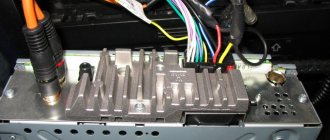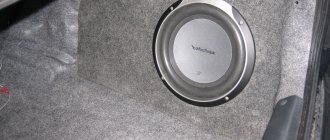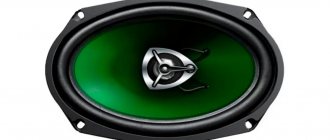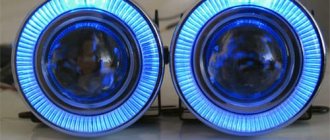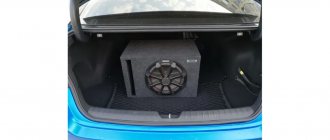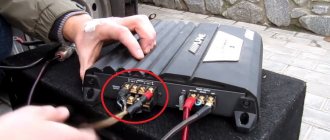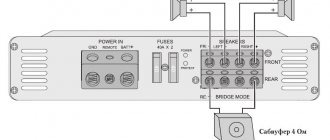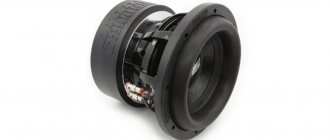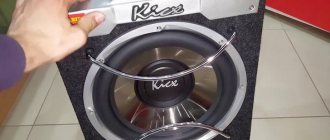To properly connect a subwoofer in a car, you need to solve several problems. First, the choice of low-frequency channel power is determined. If the car owner expects a comfortable sound picture in the cabin, then the output power of the system should not exceed 80-100 watts. In this case, the speaker can be placed on the shelf behind the back of the rear seat. With a higher output power, to obtain maximum sound pressure, the low-frequency speaker is placed in the luggage compartment of the car. Connecting an active subwoofer to a car includes supplying power to the built-in low-frequency amplifier and connecting the input terminals to the radio.
The main differences between active and passive subwoofers
To choose between an active and a passive subwoofer, a person must learn about the distinguishing features of each speaker system. Both devices have a common task and a similar design. But what are the differences then?
Passive subwoofer
The passive subwoofer includes a woofer, which is placed in a factory housing. There is no amplifier. The body comes in different shapes and any color, the material is wood/plywood. To transmit sound waves with a passive subwoofer, you need to purchase a separate device for power amplification.
Active subwoofer
An active subwoofer is the same passive subwoofer, but with a crossover filter and a power amplifier in one housing. If you are a person who places a strong emphasis on sound quality, then opt for this device. To connect an active subwoofer to the radio, simply turn on the power and adjust the audio signal.
Advantages and disadvantages of systems
The advantage of a passive subwoofer is rich low bass. The passive device is inexpensive, has the ability to connect additional filters, and has a simple design. The speaker does not overheat during operation.
The disadvantage of this speaker system is the lack of an external power amplifier, as well as wires for connecting it. Because of this, it takes up a lot of space in the car; this must be taken into account when choosing a subwoofer. True music lovers prefer to manually equip the acoustic system with devices that, in their opinion, provide the best sound quality. Therefore, they are much more likely to choose passive subwoofers.
The advantage of an active subwoofer is the presence of an amplifier, crossover filter, and speaker for low frequencies already built into the housing. This means that installation of this device will take less time. An active sub is a compact device.
The speaker system does not take up much space in the car and has a special handle that regulates the signal level. Speakers can be connected directly. This subwoofer is suitable for people who like to listen to rhythmic, heavy music.
Unfortunately, due to the heat generated by the amplifier, the air inside the speaker chamber heats up, which further leads to a deterioration in sound transmission. And operation at critical volume levels can lead to amplifier failure, the reason being an increase in temperature in the case.
So which speaker system is better to choose?
It is impossible to answer with certainty. Each device has its own characteristics. To make the right decision, a car enthusiast needs to take into account his financial capabilities, the characteristics of the vehicle, and also decide on the purpose of using the subwoofer.
To begin installing the subwoofer and connecting it to the car’s on-board network/standard radio, first you should:
- Prepare all necessary materials and tools (list below).
- Select a location to install the speaker system.
- Install and connect the subwoofer.
Installing a subwoofer and connecting it to the radio
List of required components and their functions:
- Power cable. Provides high-quality operation of the amplifier in the car.
- Acoustic cable. Performs the function of delivering an audio signal from an amplifier to passive speakers.
- Bulb with fuse. Protects the power wire from short circuit.
- Battery terminals. Simplifies the connection of power cables to the battery and car body.
- RCA connector (“bell”, “tulip”). The best option for transmitting an audio signal from a car radio to a device for power amplification.
To install any subwoofer you will need:
- kitchen knife;
- pliers;
- electrical insulating tape;
- cable tie;
- fuse;
- capacitor;
- ready set of wires;
- wrenches (including adjustable wrenches).
Subwoofer installation location
The location for installing the subwoofer directly depends on the vehicle model. Conventionally, there are three main classes of cars: sedan, minivan, convertible. Each of the three types must be considered separately.
- Installing a subwoofer in a sedan. The sound system can be located in the armrest in the rear seat or on the rear parcel shelf. The first option is considered preferable and more convenient.
- People who own a minivan/hatchback do not have to worry about choosing a place to install the subwoofer; a large luggage compartment will be the best place.
- Big problems can arise if you have a convertible, as there is a lack of free space. But with a strong desire, everything is possible. The subwoofer can be installed on the rear shelf.
To do this, you will need to make a flat stealth case.
In other words, installing a speaker system in any car is possible. You need to approach the organization of the process competently, do the work slowly, and make the right choice of woofer.
What wires do you need to connect the subwoofer?
In order to connect a subwoofer, you will need acoustic, interconnect and power wires. Each of these types has a specific functionality. They are often included in inexpensive sets; the quality of such sets cannot be trusted.
- Firstly, the wires may not be long enough for a proper connection.
- Secondly, despite the thick insulation, the wire itself may not be thick enough for such technical loads.
If you have already decided to purchase a set, then pay attention to the manufacturer. Branded kits will be expensive, but they will meet all the necessary requirements.
Ideally, it is better to buy these wires separately. This way, you can control the length, thickness and quality of the purchased wire based on the requirements specifically for your car and speaker system.
The speaker wires are of good thickness and have a copper base. The characteristics of the wire depend strictly on what connectors are provided on the equipment. The interconnect wire is an element in which you should invest the maximum, since here the quality directly depends on its price. The power cable directly affects the safety of the car, so you shouldn’t skimp on it either. The optimal length is around five meters.
Connecting to an amplifier
Connecting a passive subwoofer
Installing a passive subwoofer will take twice as long as installing an active one. But the duration of installation and connection is also influenced by the experience of the car owner and the vehicle model. Those who are planning to connect a passive subwoofer on their own need to be patient and strictly follow the instructions below. If you are in doubt, it is better to seek help from a specialist.
Connecting and installing a passive subwoofer without an amplifier
The process of installing a passive subwoofer without an amplifying device is carried out in several stages:
- Locate the RCA outputs on the back of the device.
- Using the line outputs, connect the sub to the car radio using composite connectors.
- Cut the power cable and pass it through the corrugated tube. Then run a wire from the positive terminal of the battery to the speaker system.
- Repeat step three with the negative clamp.
- Your work involves two plugs, so use a splitter.
- Install the fuse near the battery.
- Remove the installed wiring into the interior trim.
- Check the operation of the device.
Connecting a passive subwoofer through an amplifier
Instructions for installing a passive subwoofer through an amplifier:
- Remove all terminals from the battery (you will avoid the risk of a short circuit).
- Locate the cable harness under the hood of the vehicle. Pull the wires through the service hole (on some machine models it is closed with a rubber plug). If there is no passage, then drill a small hole.
- Route the power cable through the interior. Fill the hole with sealant. Be careful, the wire must be laid without kinks.
- In the car, the wiring is also laid in the opposite direction: from the passenger compartment to the luggage compartment, also through a special hole. After these steps, fill both passages with sealant if you drilled them yourself.
- Observe polarity when you begin connecting power to the subwoofer. Then connect the amplifier to the car radio (use an RCA cable, as well as a solid wire that will control the power to the amplifier).
- Connect the bells according to the colors of the connectors. If you connect the positive power cable, the sub and car radio will turn on simultaneously.
- Take all the available wires and route them through the interior, then connect the composite connectors to the amplifier ports.
- Install a capacitor.
- Connect the terminal to the battery.
Advice! When you start removing the radio, use a kitchen knife or special flat keys.
How to connect minus
The cross-section of the cable for connecting the minus to the subwoofer can be taken a little smaller than for supplying the plus. And you will need a shorter cable length of about 1 meter. If the subwoofer power is more than 500 W, do not attach the negative wire to the body. It must be stretched to the battery.
The minus in this system can be supplied from the machine body. But find some reliable connection that will ensure good contact and secure fit. For example, you can extend the negative cable from the seat mounting bolt. If the subwoofer is located at the rear, away from the rear seat. But without twists and other unreliable connections.
Example of minus connection
Under the bolt, take a terminal with a hole in the middle of a suitable size, and not in the form of a “plug”. Unscrew the bolt, clean the head and rod, the edges of the hole, put on the terminal from the cable and install it in place. Lay the route so that the possibility of damage is minimal.
You can find an area that has been cleared of paint and screw the negative cable there. But not with self-tapping screws, but with a bolt. And remove dirt and rust, if any. Drill a hole in clean metal and drive a bolt into it with a contact from the negative cable mounted on it. And the contact must be very strong and tight.
Connecting an active subwoofer
The active subwoofer is connected according to the following scheme:
- You need to know that the selected subwoofer is mounted using a power cable and a wire transmitting the audio signal. Connect the cable for transmitting electricity using industrial frequency currents to the positive side of the battery.
- Be sure to install a fuse that will protect the electrical connections in the machine from a short circuit. It is best to use the place under the hood, closer to the battery.
- The minus cable should be attached to the car body (choose a place that will be closest to the subwoofer). Connect the second end of the cable to the GND wire.
- If the radio already has separate connectors for connecting an active subwoofer, then the switching is easier: run a coaxial wire (shielded) with the corresponding connector. Insert one end of the cable into the Sub Out connector, and the other end into the LFE connector.
By strictly following the steps, you will install the speaker system in a couple of hours. Be sure to observe polarity!
Make-up capacitor
There is one more nuance when connecting a subwoofer. As the listening volume increases, “dips” may occur in the music. This is due to the “drawdown” in nutrition. That is, the battery is not capable of quickly delivering high current.
For powerful subs, a subwoofer feed capacitor is required
To exclude them from the power supply circuit of the amplifier or subwoofer, connect a capacitor with a capacity of 0.5-2.0 farads in parallel to the power terminals. It acts as an additional power source.
Audio wires
If you have not yet encountered connecting audio equipment, you will definitely be surprised by the cross-section of audio wires. Subwoofers have serious power and the wires running to them are thick. They can be distinguished from power ones by the presence of special connectors at the ends. They are called “tulip” for their similarity in shape, and the inputs with which they “join” are labeled RCA.
To connect you need a good shielded cable
Speakers often come with wires for connection. Do not use simple RCA wires used in everyday life to connect music. centers or TV. They have a very poor screen and the input of the amplifier will receive interference in the form of a buzz from the generator and the crackling of spark discharges. If you use it, the sound will not be normal. Even if the equipment is chosen perfectly.
Security measures
When installing a subwoofer and amplifier yourself, you must follow certain rules:
- you cannot start work without removing the terminals from the battery;
- do not forget about de-energizing all circuits to which the connection will be made;
- use electrical insulating tape, corrugated tube, clamps to reliably protect all wire connections;
- you must have only high-quality wiring;
- do not allow sharp bends in the wires;
- choose a fuse that matches the rating data of the connected devices;
- securely fix the acoustic equipment in the car; nothing should move during operation.
By following the above safety precautions, you will not damage your vehicle and avoid the risk of fire.
Problems that may arise when connecting a subwoofer
Car enthusiasts who decide to independently install an active or passive subwoofer often encounter the following problems:
- No sound when turning on the subwoofer. The device is turned on, the “power” button is lit, but there is no sound. The problem can be solved by installing an additional ground wire from the battery. The cable must have a cross-section comparable to the grounding cross-section of the amplifier, otherwise there is a possibility of a short circuit.
- If you connect an active subwoofer to the wires coming from the car radio, the volume will be reduced. In such a situation, disconnect one signal cable, then operation will be restored. The amplifier is designed with a signal doubler, so only one cable is required.
- The active speaker is installed via an RCA connector. The sound is quiet, if you try to increase the volume, noise occurs. The problem lies in the insufficient cross-sectional area.
Ground/mass wire/case/minus – a wire connecting the negative terminal of an electrical element to the body of the product in which it is installed.
